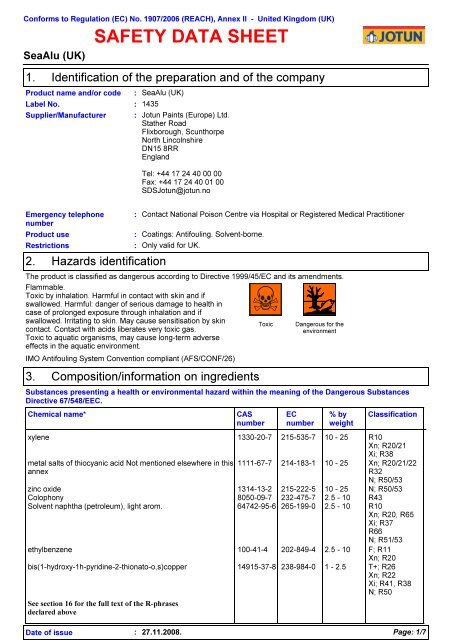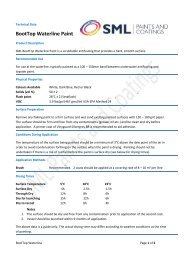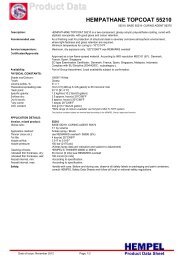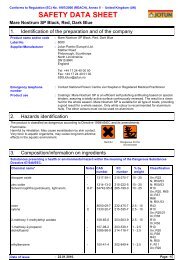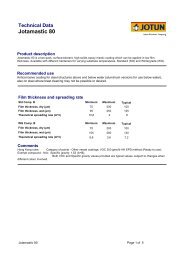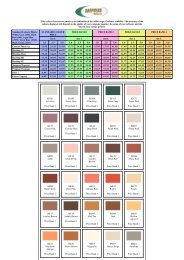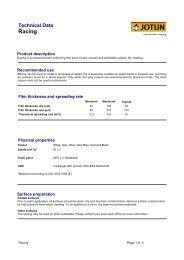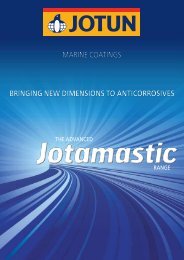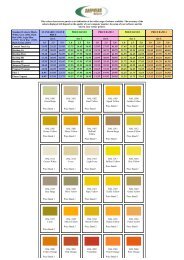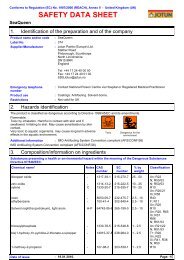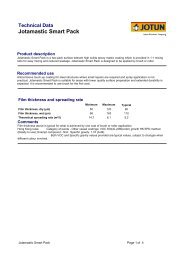SAFETY DATA SHEET - Anodes Direct
SAFETY DATA SHEET - Anodes Direct
SAFETY DATA SHEET - Anodes Direct
- No tags were found...
Create successful ePaper yourself
Turn your PDF publications into a flip-book with our unique Google optimized e-Paper software.
SeaAlu (UK)Storage:during the spraying process and until such time as the particulates and solventvapour concentration has fallen below the exposure limits.Store in accordance with local regulations. Observe label precautions. Store in a dry,cool and well-ventilated area. Keep away from heat and direct sunlight.Keep away from sources of ignition. Keep away from: oxidising agents, strongalkalis, strong acids.No smoking. Prevent unauthorised access. Containers that have been opened mustbe carefully resealed and kept upright to prevent leakage. Do not empty into drains.8. Exposure controls/personal protectionEngineering measuresIngredient namexyleneSolvent naphtha (petroleum), lightarom.ethylbenzenebis(1-hydroxy-1h-pyridine-2-thionatoo,s)copper:Provide adequate ventilation. Where reasonably practicable, this should be achievedby the use of local exhaust ventilation and good general extraction. If these are notsufficient to maintain concentrations of particulates and solvent vapours below theOEL, suitable respiratory protection must be worn.Occupational exposure limitsEH40-WEL (United Kingdom (UK), 9/2006). Absorbed throughskin.WEL 15 min limit: 441 mg/m³ 15 minute(s).WEL 15 min limit: 100 ppm 15 minute(s).WEL 8 hrs limit: 220 mg/m³ 8 hour(s).WEL 8 hrs limit: 50 ppm 8 hour(s).EH40-WEL (United Kingdom (UK), 1/2005).TWA: 125 mg/m³ 8 hour(s). Form: All formsTWA: 25 ppm 8 hour(s). Form: All formsEH40/2005 WELs (United Kingdom (UK), 8/2007). Absorbedthrough skin.STEL: 552 mg/m³ 15 minute(s).STEL: 125 ppm 15 minute(s).TWA: 100 ppm 8 hour(s).TWA: 441 mg/m³ 8 hour(s).Arch Chemicals (Europe, 2002).TWA: 0,35 mg/m³ 8 hour(s).Personal protective equipmentRespiratory system :Skin and body:Hands:If workers are exposed to concentrations above the exposure limit, they must useappropriate, certified respirators. Use respiratory mask with charcoal and dust filterwhen spraying this product.(as filter combination A2-P3). In confined spaces, usecompressed-air or fresh-air respiratory equipment. When use of roller or brush,consider use of charcoalfilter.Personnel should wear antistatic clothing made of natural fibres or of hightemperature-resistantsynthetic fibres.For prolonged or repeated handling, use the following type of gloves: gloves:polyvinyl alcohol or nitrile.Eyes9.:Barrier creams may help to protect the exposed areas of the skin but should not beapplied once exposure has occurred.For right choice of glove materials, with focus on chemical resistance and time ofpenetration, seek advice by the supplier of chemical resistant gloves.The user must check that the final choice of type of glove selected for handling thisproduct is the most appropriate and takes into account the particular conditions ofuse, as included in the user's risk assessment.Physical and chemical propertiesPhysical state: Liquid.Odour: Hydrocarbon.Colour: Various colours.Flash point: Closed cup: 25°C (77°F)Density : 1.4 g/cm 3Use safety eyewear designed to protect against splash of liquids.Vapour density : Highest known value: 3.7 (Air = 1) (Xylene). Weighted average: 3.7 (Air = 1)Explosion limits : 1.1 - 7%Date of issue : 27.11.2008. Page: 3/7
SeaAlu (UK)Solubility10.Stability and reactivity:Insoluble in the following materials: cold water and hot water.Stable under recommended storage and handling conditions (see section 7).Hazardous decomposition products: carbon monoxide, carbon dioxide, smoke, oxides of nitrogen.Keep away from the following materials to prevent strong exothermic reactions: oxidising agents, strong alkalis, strongacids.11.Toxicological informationThere is no data available on the preparation itself. The preparation has been assessed following the conventionalmethod of the Dangerous Preparations <strong>Direct</strong>ive 1999/45/EC and classified for toxicological hazards accordingly. Seesections 2 and 15 for details.Exposure to component solvent vapour concentrations in excess of the stated occupational exposure limit may result inadverse health effects such as mucous membrane and respiratory system irritation and adverse effects on the kidneys,liver and central nervous system. Solvents may cause some of the above effects by absorption through the skin.Symptoms and signs include headache, dizziness, fatigue, muscular weakness, drowsiness and, in extreme cases, lossof consciousness. Repeated or prolonged contact with the preparation may cause removal of natural fat from the skin,resulting in non-allergic contact dermatitis and absorption through the skin. If splashed in the eyes, the liquid may causeirritation and reversible damage.Contains: Colophony. May produce an allergic reaction.12.Ecological informationThere is no data available on the preparation itself.Do not allow to enter drains or watercourses.The preparation has been assessed following the conventional method of the Dangerous Preparations <strong>Direct</strong>ive1999/45/EC and is classified for eco-toxicological properties accordingly. See Sections 2 and 15 for details.Aquatic ecotoxicityProduct/ingredient name Test ResultSpecies Exposurexylene Mortality Acute LC50 8500 ug/LMarine waterCrustaceans -Daggerbladegrass shrimp-Palaemonetespugio48 hoursmetal salts of thiocyanic acid Notmentioned elsewhere in this annexMortality Acute LC50 3300 to 4093ug/L Fresh waterIntoxicationMortalityMortalityMortalityAcute EC50 20 to 25 ppbFresh waterAcute LC50 31 to 39 ppbFresh waterAcute LC50 >55 ppbFresh waterAcute LC50 9,6 to 24 ppbMarine waterzinc oxide Mortality Acute LC50 1,1 to 2,5ppm Fresh waterFish -Rainbowtrout,donaldsontrout -OncorhynchusmykissDaphnia -Water flea -DaphniamagnaFish -Rainbowtrout,donaldsontrout -OncorhynchusmykissFish - Bluegill- LepomismacrochirusFish - Plaice,sand dab -PleuronectesplatessaFish -Rainbowtrout,donaldson96 hours48 hours96 hours96 hours96 hours96 hoursDate of issue : 27.11.2008. Page: 4/7
SeaAlu (UK)Ecological informationBiodegradabilityProduct/ingredient name Aquatic half-life Photolysis Biodegradabilityxylene - - ReadilySolvent naphtha (petroleum), lightarom.- - Not readilyBioaccumulative potentialMortalityAcute LC50 98 ug/LFresh watertrout -OncorhynchusmykissDaphnia -Water flea -DaphniamagnaProduct/ingredient nameLogPow BCF Potentialxylene 3,12 - high48 hoursSolvent naphtha (petroleum), light arom. - Acute EC50
SeaAlu (UK)16.Other informationCEPE Classification : 1Full text of R-phrasesreferred to in sections 2 and3 - United Kingdom (UK)The information in this Safety Data Sheet is required pursuant to EU <strong>Direct</strong>ive 91/155/EEC and its amendments.Date of issue : 27.11.2008.Version: 4Indicates information that has changed from previously issued version.Notice to reader:R11- Highly flammable.R10- Flammable.R26- Very toxic by inhalation.R23- Toxic by inhalation.R20- Harmful by inhalation.R22- Harmful if swallowed.R20/21- Harmful by inhalation and in contact with skin.R20/21/22- Harmful by inhalation, in contact with skin and if swallowed.R21/22- Harmful in contact with skin and if swallowed.R48/20/22- Harmful: danger of serious damage to health in case of prolongedexposure through inhalation and if swallowed.R65- Harmful: may cause lung damage if swallowed.R41- Risk of serious damage to eyes.R37- Irritating to respiratory system.R38- Irritating to skin.R43- May cause sensitisation by skin contact.R32- Contact with acids liberates very toxic gas.R66- Repeated exposure may cause skin dryness or cracking.R50- Very toxic to aquatic organisms.R50/53- Very toxic to aquatic organisms, may cause long-term adverse effects in theaquatic environment.R51/53- Toxic to aquatic organisms, may cause long-term adverse effects in theaquatic environment.The information in this SDS is based on the present state of our knowledge and on current laws. The productis not to be used for purposes other than those specified under section 1 without first obtaining writtenhandling instructions. It is always the responsibility of the user to take all necessary steps to fulfil thedemands set out in the local rules and legislation. The information in this SDS is meant to be a description ofthe safety requirements for our product. It is not to be considered a guarantee of the product's properties.Date of issue : 27.11.2008. Page: 7/7


